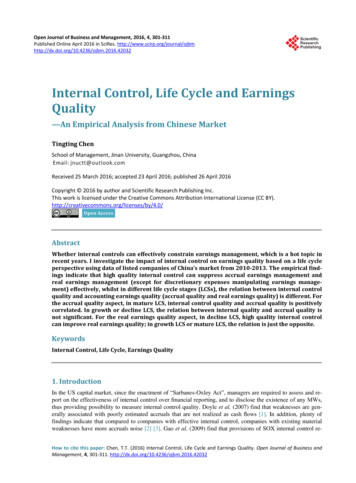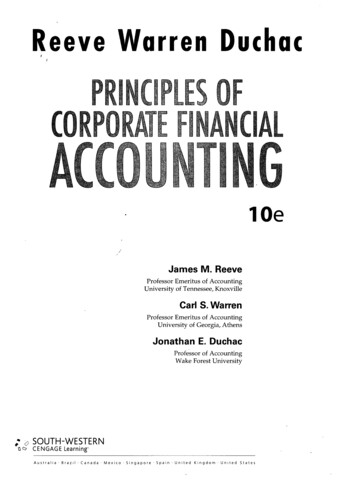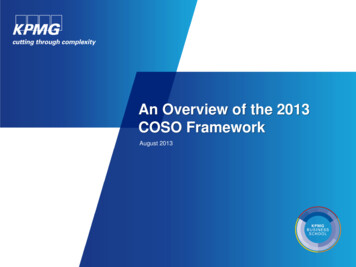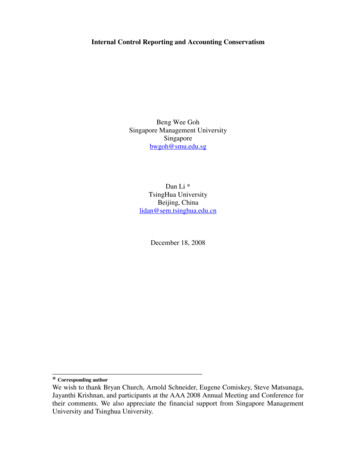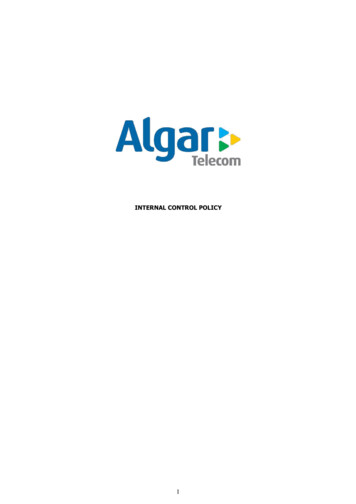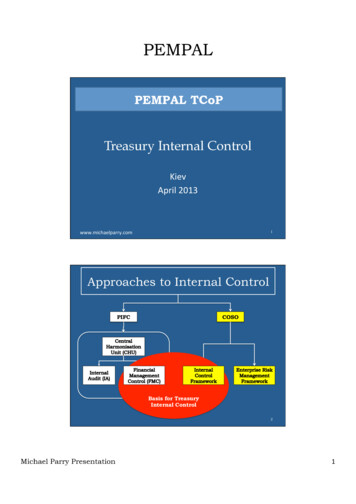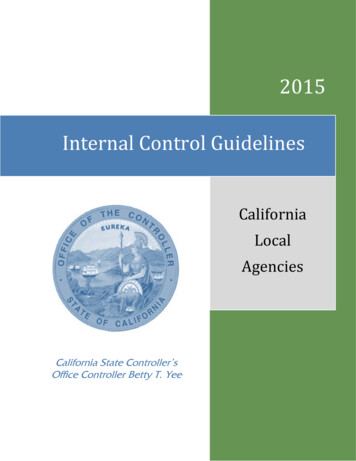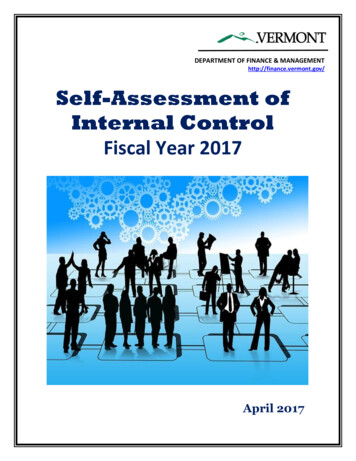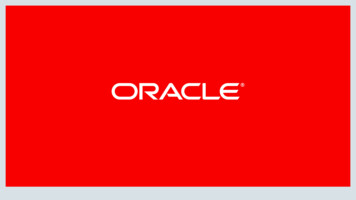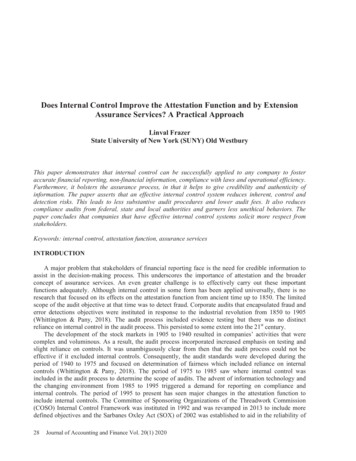
Transcription
Does Internal Control Improve the Attestation Function and by ExtensionAssurance Services? A Practical ApproachLinval FrazerState University of New York (SUNY) Old WestburyThis paper demonstrates that internal control can be successfully applied to any company to fosteraccurate financial reporting, non-financial information, compliance with laws and operational efficiency.Furthermore, it bolsters the assurance process, in that it helps to give credibility and authenticity ofinformation. The paper asserts that an effective internal control system reduces inherent, control anddetection risks. This leads to less substantive audit procedures and lower audit fees. It also reducescompliance audits from federal, state and local authorities and garners less unethical behaviors. Thepaper concludes that companies that have effective internal control systems solicit more respect fromstakeholders.Keywords: internal control, attestation function, assurance servicesINTRODUCTIONA major problem that stakeholders of financial reporting face is the need for credible information toassist in the decision-making process. This underscores the importance of attestation and the broaderconcept of assurance services. An even greater challenge is to effectively carry out these importantfunctions adequately. Although internal control in some form has been applied universally, there is noresearch that focused on its effects on the attestation function from ancient time up to 1850. The limitedscope of the audit objective at that time was to detect fraud. Corporate audits that encapsulated fraud anderror detections objectives were instituted in response to the industrial revolution from 1850 to 1905(Whittington & Pany, 2018). The audit process included evidence testing but there was no distinctreliance on internal control in the audit process. This persisted to some extent into the 21st century.The development of the stock markets in 1905 to 1940 resulted in companies’ activities that werecomplex and voluminous. As a result, the audit process incorporated increased emphasis on testing andslight reliance on controls. It was unambiguously clear from then that the audit process could not beeffective if it excluded internal controls. Consequently, the audit standards were developed during theperiod of 1940 to 1975 and focused on determination of fairness which included reliance on internalcontrols (Whittington & Pany, 2018). The period of 1975 to 1985 saw where internal control wasincluded in the audit process to determine the scope of audits. The advent of information technology andthe changing environment from 1985 to 1995 triggered a demand for reporting on compliance andinternal controls. The period of 1995 to present has seen major changes in the attestation function toinclude internal controls. The Committee of Sponsoring Organizations of the Threadwork Commission(COSO) Internal Control Framework was instituted in 1992 and was revamped in 2013 to include moredefined objectives and the Sarbanes Oxley Act (SOX) of 2002 was established to aid in the reliability of28Journal of Accounting and Finance Vol. 20(1) 2020
financial information and reporting processes. Both COSO and SOX overtime have been 2 of the mosteffective engines of internal controls and have played an indelible role in the quality and reliability ofinformation.The paper begins with a brief overview of the background of the problem and the distinction betweenassurance and attestation services. A focused discussion on COSO and SOX follows. These twoinstitutions were created to improve the quality and reliability of information. The next sections includediscussions on the external and internal audit functions. Finally, the paper briefly discusses blockchaintechnology.Assurance ServicesAssurance services are independent professional services that increase the reliability and quality ofinformation received from various entities for decision makers. Users of these services rely on theinformation provided because providers of these services are considered independent, unbiased andqualified (Spiceland, Sep & Nelson, 2013). As such, these services help to improve the relevance,reliability, consistency and transparency of the information. An assurance engagement is a service that isdesigned and conducted by an accountant to improve the quality of information for decision makers andthird parties against an applicable framework (criteria) such as Generally Accepted Accounting Principles(GAAP), International Financial Reporting Standards (IFRS) or Other Comprehensive Basis ofAccounting (OCBOA). Assurance services are extended to include areas in risk assessment, informationsystems reliability and e-commerce. Some examples of assurance services are: reporting on personalfinancial statements; personal financial plans; compilation of financial statements; pro forma financialstatements and information.Attestation ServicesAn attestation engagement is a part of assurance services. It is a process where the accountantexamines evidence and reports on the reliability and relevance of the information, or an assertion made byanother party. There are three types of attestation services: examination, review and agreed – uponprocedures. A more thorough discussion will follow regarding these services in the external functionsection. Pursuant to attestation standard (AT 101.1), an attest engagement is designed to issue anexamination, review, or agreed upon procedures report on the subject matter that is the responsibility ofanother party. AICPA Code of Professional Conduct (ET 92.01) defines attestation services asengagements that require independence. Independence is defined in ET 100.06 of the AICPA as that offact and appearance. CPAs may attest to many types of subject matters such as financial statements,financial forecasts and projections, internal control, compliance with laws regulations and contracts. Theattest function adds value to information because a qualified and competent third party, the CPA, providesassurance over a subject matter prepared by management or another party responsible for the information.Internal Controls/COSOInternal control encompasses the policies, rules, and procedures enacted by management to providereasonable assurance that financial reporting is reliable, the operations are effective and efficient, and theactivities comply with applicable laws and regulations. Financial reporting objectives relate to thereliability, timeliness, and transparency of financial and nonfinancial reporting for internal and externaluses. Operational efficiency objectives relate to the effectiveness and efficiency of operations andincorporate the achievement of financial performance goals and the safeguarding of assets. Complianceobjectives relate to complying with applicable laws and regulations (COSO, 1992; 2013).Although organizations sizes and objectives vary, they all need some form of internal control systemin place to be successful at what they do. There are three types of controls used to accomplish thereliability of financial reporting, compliance and operational efficiency. These three controls are classifiedas corrective controls, detective controls and preventative controls. A corrective control is used to remedyor correct a misstatement. A common example of a corrective control is ensuring that the company hasmaster files and or a backup file. In the event there is a material misstatement from data error or fraud, theJournal of Accounting and Finance Vol. 20(1) 202029
back up or master file can be used to correct this problem. A detective control is needed or used toidentify misstatements after they have occurred. Bank reconciliation is a frequent example of detectivecontrol that is used to identify misstatements from cash receipts and disbursements. Preventative controlsare used to prevent the occurrence of material misstatement. Most companies big and small, find ways toimplement preventative controls through policies. These policies are used as preventative measuresagainst material misstatements. A typical example of preventative control is enactment of policies toseparate the authorization, custody of assets and recording functions. It is through these lens that scholarsand practitioners have concluded that internal control can indeed bolster the assurance services.In 1992, COSO established the internal control integrated framework to develop effective internalcontrol systems. This framework provides direction to any business that wishes to establish an effectiveinternal control system. This now recognized framework has five interrelated components: controlenvironment, risk assessment, control activities, information and communication, and monitoring (COSO,1992). In 2013, COSO’s Board of Directors added 17 internal control principles to the five interrelatedcomponents because they are presumed very important in assessing the five components.The five major components of COSO (1992) internal control integrated framework are part of aholistic framework needed to strengthen efficiency within the management of any organization.Throughout this holistic framework, a variety of activities and steps are taken to ensure that theorganizations do not provide opportunities for the manifestation of fraudulent behaviors by employees(COSO, 1992). The framework should be assessed regularly for clarity so that the implemented internalcontrols function throughout the lifespans of the organizations (COSO, 1992). The five components ofinternal control also work harmoniously to detect, prevent, or correct errors and or misstatements in theoverall business operations (COSO, 1992). For the process of internal control to be seen as viable, thefinancial statements generated from all business activities must be authentic and noteworthy in accountingterms.Control EnvironmentThe control environment is the foundation of internal control because it sets the organizational toneby influencing the control consciousness of the organizational workforce. It is the foundation for all othercomponents of internal control because it provides discipline; structure; integrity and ethical values,employee competence, management’s philosophy and operating style, and the leadership provided bysenior management and the board of directors (COSO, 1992; 2013). According to COSO (2013), fivebasic principles are germane to the control environment of a company:1. Demonstrates commitment to integrity and ethical values.2. Board of directors demonstrates independence from management and exercises oversightresponsibility of internal control.3. Establishment of effective structure, including reporting lines, and appropriate authorities andresponsibilities.4. Commitment to attract, develop, and retain competent employees.5. Holding employees responsible for internal control responsibilities.Risk AssessmentRisk assessment is the process of identifying, analyzing, and responding to risks from external andinternal sources that threaten the achievement of organizational objectives. Every organization, be itprivate or public, large or small, faces risks from external and internal sources that must be assessed(COSO, 1992). Because economic, industry, regulatory, and operating conditions continue to evolve,mechanisms are needed to identify and deal with the special risks associated with change. COSO (2013)identified five basic principles that companies should carry out when performing effective riskassessment.1. Clearly specify objectives to facilitate the identification and assessment of risks related toorganizational objectives.30Journal of Accounting and Finance Vol. 20(1) 2020
2. Identify and analyze risks to the achievement of organizational objectives to determine howthey might be managed.3. Consider potential fraud related to the achievement of objectives.4. Identify and assess changes that could impact internal control.Control ActivitiesControl activities are policies and procedures that help to mitigate the risk that organizationalobjectives will not be met. These policies and procedures ensure the ways that management directiveswill be carried out. Control activities include approvals, authorizations, verifications, reconciliations,reviews of operating performance, safeguarding of assets, and segregation of duties. These actionsdissuade fraud or theft activities that could eventually lead to losses. COSO (2013) identified three basicprinciples of control activities:1. Select and develop general control activities that mitigate the risk of achieving organizationalobjectives to an acceptable level.2. Select and develop general control activities over technology to support organizationalobjectives.3. Deploy control activities through policies that establish what is expected and throughprocedures that put policies into action.Information and CommunicationInformation is needed at all levels of organizations to assist managers in achieving organizationalobjectives. Pertinent information must be identified, captured, and communicated in forms and timeframes that enable people to carry out their responsibilities. Information systems facilitate the productionof operational, financial, and compliance-related reports that make it possible to run and controlorganizations (COSO, 1992; 2013).Information systems deal not only with internally generated data but also information about externalevents, activities, and conditions necessary to inform business decision making and external reporting(COSO, 1992). Effective communication must also occur in a broader sense by flowing down, across, andup all levels in organizations (COSO, 1992). All personnel must receive a clear message from topmanagement that control responsibilities must be taken seriously. Employees must understand their ownroles in the internal control system and how individual activities relate to the work of others. In addition,they must have a means of communicating significant information upward. Effective communication alsomust exist with external parties, such as customers, suppliers, regulators, and shareholders (COSO, 1992).Pursuant to COSO (2013), the three basic principles of effective communication are as follows:1. Obtaining and using relevant information to support the functioning of other internal controlcomponents.2. Communicating internally the information necessary to support the functioning of othercomponents of internal control.3. Communicating with external parties regarding matters affecting the functioning of othercomponents of internal control.MonitoringMonitoring is the process of determining whether all components of internal control, including theprinciples in each component, are in place and are functioning as intended (COSO, 2013). Monitoringassesses the quality of the internal control system’s performance over time through ongoing monitoringactivities, separate evaluations, or a combination of the two (COSO, 1992). Ongoing monitoring, whichoccurs in the course of operations, includes regular management and supervisory activities as well asother actions that personnel undertake while performing their duties. The scope and frequency of separateevaluations depend primarily on an assessment of risks and the effectiveness of ongoing monitoringprocedures (COSO, 1992).Journal of Accounting and Finance Vol. 20(1) 202031
Internal control deficiencies should be reported upward, with serious matters reported to topmanagement and the board of directors (COSO, 1992). According to COSO (2013), the last two basicprinciples of the 17 involve (1) Selecting, developing, and performing ongoing and separate monitoringevaluations to determine that the components of internal control are present and functioning properly, and(2) evaluating and communicating internal control deficiencies in a timely manner to those responsible fortaking corrective action, including senior management and the board of directors and their auditcommittees.Sarbanes-Oxley ActSarbanes Oxley Act (SOX) contributes to internal control, and assurance services. Although SOXprimarily applies to public companies and is often more expensive for private companies, some of itspolicies have been used by private companies in furtherance of their objectives. Sarbanes Oxley Act(SOX) was enacted in 2002 in response to corporate irregularities and the implosion of many companiesin 2001. Accounting irregularities by the public accounting firm Arthur Andersen and accountingscandals with public companies such as Worldcom, Enron, Xerox, Merck and Adelphia among many,created a shockwave in the financial market. The credibility of the accounting profession and corporateAmerica was questioned and met with public outrage and consternation. Congress had no choice but torespond to the increased pressure to pass a law that would regain creditability, and investor confidence tofinancial reporting process and the market. SOX was described as the most far-reaching reform of U.S.business practices since the Securities Act of 1933 (Rice & Weber, 2012).The purpose of SOX was to improve quality and transparency in financial reporting and independentaudits, strengthen the independence of firms that audit public trading companies, and increase corporateresponsibility and the usefulness of corporate financial disclosure. Although SOX was passed primarily inresponse to wrongdoing and fiscal mismanagement in public companies, one of its outcomes has beengreater accountability within the private sector, regardless of the size and status (private vs. public) of thecompany. Some of the key provisions are:1. Creating the Public Company Accounting Oversight Board (PCAOB). This board hasoversight and enforcement authority. It is responsible for auditing, quality control, andindependence standards and rules for publicly traded companies.2. It has implemented and is responsible for stronger independence rules for auditors auditingpublicly traded companies. Examples are audit partners rotation and the prohibition of othertypes of accounting and consulting services while auditing firm is engaged to audit client.3. Chief Executive Officers (CEO) and Chief Financial Officers (CFO) or other personnel thathold similar positions with similar responsibilities of publicly traded companies are requiredto validate and certify that financial statements and disclosures are accurate and complete.Failure to do so can lead to forfeiture of bonus or compensation associated with therestatement of a company’s financial statements.4. Publicly traded companies are required to have audit committees. Members of auditcommittee are required to be independent with financial expertise.5. Code of ethics is required.Pursuant to Section 404 of SOX, managers of public companies are required to attest to theeffectiveness of the internal controls of their companies. Section 404 a controversial provision of SOXrequires companies’ managements maintain and document effective internal controls and report on theadequacy of the internal controls. This provision also requires auditors of publicly trading companies toexpress an opinion on the effectiveness of internal control over financial reporting. While academics,pundits and practitioners agree that the 404 provision was beneficial, some argued about the costassociated with implementing and maintaining the controls. The benefits outweigh the costs becausecompanies with more effective internal control affect investors’ confidence, risk assessment andultimately the value of the companies as reflected in their stock prices (Frazer, 2018; Kim, Yeung &Zhou, 2013). The cost of section 404 compliance by public companies was high in the first couple of32Journal of Accounting and Finance Vol. 20(1) 2020
years of implementation but went down significantly over a period of time. The cost of maintaining 404compliance have been reduced also by the efficiency of internal control audits.Section 802 of SOX amends the federal obstruction of justice statute. It is now a felony to knowinglydestroy, conceal, cover up, or falsify documentation or records to impede or obstruct federalinvestigations. SOX imposes fines and up to 20 years in prison for knowingly destroying, altering, orfalsifying records with the intent to impede or influence federal investigations, including existinggovernment proceedings against private companies. Section 806 of SOX, under the whistleblowerprotection act, purports that it is against the law for employers to discriminate or take action againstemployees who disclose information or evidence against fraud or irregularities.Although SOX were not expressly applicable to private companies, many of the requirementsimposed by SOX have become best business practices and are now considered industry standards. Thepressure on private companies to comply with SOX is coming from many different directions. Lenders,insurers, public merger partners, potential litigants, and state governments are all looking at the SOX-typecontrol mechanisms installed by private companies. It must be noted, however, that private companies arenot required to be in technical compliance with SOX. As such, private companies can pick and choose theprovisions that they want to adopt. Private companies seem to be implementing most of the easierchanges, such as adopting a code of ethics for officers and appointing independent directors and auditcommittees. The provision of SOX that affects private companies more adversely is Section 404, whichrequires companies to report the effectiveness of internal control over financial reporting at the end ofeach fiscal or calendar year. This provision requires a report of an external auditor attesting tomanagement’s assertion of the effectiveness of the internal control in the organization.External Audit FunctionThe external audit function is a part of the attestation and monitoring process. Independent externalauditors are required to verify if companies are adhering to accounting policies and practices consistentwith GAAP, IFRS and or any other suitable criteria. Examination, review and agreed upon procedures areused to accomplish the attestation and external audit function. An audit examination is the highest level ofassurance provided by CPAs. In an audit examination, the accountant gives reasonable assurance whetherthe presentation of the assertion, taken as a whole, conforms with the applicable criteria. An audit is thegathering and evaluation of evidence about information. Evidence is any information used by the auditorto determine whether the information being audited is consistent and stated in accordance with theestablished criteria. To achieve the objective of an acceptable audit, the auditor must obtain appropriatesufficient quality and volume of evidence. This process requires the auditor to be competent in evaluatingwhether the information gathered is analogous with the prescribed criteria (Porter, Simon & Hatherly,2014).There are three major types of audits that lends credibility to information. They are financial audits,compliance audits and operational audits. Financial audit is the process whereby an auditor or CPA servesas an independent intermediary, gathers and evaluates evidence of the company’s financial statements, toexpress a professional opinion about whether the statements fairly represent the company’s financialposition and operation. Financial audits normally include the company’s balance sheet, income statement,retained earnings and statement of cash flows. This audit is done from a historical perspective to ascertainwhether the financial statements have been prepared in accordance with the prescribed criteria.The review is an attestation function that gives limited or negative assurance. This is based on inquiryand analytical procedures. The attestation function is lower than the audit function and does not givereasonable assurance that the financial statements are in accordance with a prescribed standard. Instead, itasserts that the auditor is not aware of any information that the financial statements or subject matter arenot in compliance with the applicable standard or criteria. In an engagement to review the financialstatements of a company, the auditor obtains evidence from analytical procedures and inquiries. Auditorsuse several tools to obtain evidence such as ratio analysis, benchmarking, trend analysis, vertical analysisand horizontal analysis. The review engagement does not require the auditor to obtain an understanding ofinternal control, assess risk or conduct substantive audit procedures. Although the review engagementJournal of Accounting and Finance Vol. 20(1) 202033
does not require an understanding of the company’s internal control, by having an effective internalcontrol system in place, it increases the reliability of the review report. This is because there is a directcorrelation with increased internal controls and the accuracy of the financial statements of companies(Rice and Weber, 2012).Internal control improves the financial audit function by reducing the amount of audit proceduresperformed by an auditor. Internal control is integral to the risk assessment process. Auditors are requiredto assess the audit risk prior to doing the audit examination. In doing the risk assessment, auditors arerequired to design and implement risk assessment procedures to obtain an understanding of the client’sinternal control over the financial statements. Auditors test the operating effectiveness of the internalcontrols to determine if they prevent or detect misstatements. If the controls are working efficiently,auditors can rely on the controls, and apply fewer substantive procedures such as test of details ofaccounts balances, transactions and disclosures to detect material misstatement. Auditors have to consideraudit risk in their risk assessment. This should be assessed throughout the audit. Importantly, externalauditors must not rely exclusively on the effectiveness of internal controls to determine the accuracy of acompany’s financial statement without applying substantive audit procedures.Audit RiskAudit risk is a process whereby the auditor might incorrectly fail to modify her opinion on thefinancial statements that are materially misstated. That is, the auditor issues an unqualified opinion on acompany’s financial statements that is materially inconsistent with generally accepted accountingprinciples. The amount of audit evidence that is needed by the auditor is based on her assessment of theaudit risk. The lower the audit risk, the less persuasive evidence is needed. The higher the audit risk themore substantive audit procedures are used. Audit risk must be assessed at the financial statements’assertion level and for all significant account balances, transactions and disclosures. Audit risk has threecomponents; inherent risk, control risk and detection risk (AR IR X CR X DR).Inherent risk is the likelihood of a material misstatement of an assertion prior to considering theclient’s internal control. The nature of the client and its environment play an important role in assessinginherent risk. High inherent risk assessment might be determined based on misstatement detected in prioraudits, going concern issues, operating activities and results tied to economic factors. Other factorsinclude valuation, significant judgement by managers, difficult accounting issues, and human resourceissues such as high turnover. The auditor uses these factors to determine if she will accept the auditengagement and if she accepts the audit engagement, the amount of audit procedures needed to obtainsufficient appropriate evidence to issue an opinion. Also, importantly the scope and cost to complete theexamination.Control risk is the risk that a material misstatement may occur at the assertion level and the internalcontrol did not prevent or detect it in a timely manner. The auditor evaluates the effectiveness of thedesign and operation of the internal control to the fair presentation of the financial statements. If theauditor assesses control risk low, then she will rely on the controls and apply fewer substantiveprocedures. If the auditor assesses control risk high, she may not rely on the internal controls and she willhave to apply more substantive procedures. Therefore, it is clear that having an effective internal controlsystem lowers the control risk, the audit procedures and the cost associated with the audit examination.Detection risk is the risk that the auditor’s procedures will not detect a material misstatement at anassertion level. Detection risk is independent of inherent and control risks. Inherent and control risks arefinancial statement risks while detection risk is determined by the effectiveness of the audit procedures.Detection risk exist because of ineffective audit procedures and sampling.SamplingInternal control can improve the sampling process and in turn the attestation function. Sampling is theprocess of selecting and evaluating less than the entire amount from a population of audit evidence thatrepresents the entire population. Complex and voluminous companies’ transactions require effectivesampling procedures. Attribute and discovery sampling are sampling processes used by auditors to test34Journal of Accounting and Finance Vol. 20(1) 2020
controls. They test for deviation of performance from prescribed controls. Other statistical samplingincludes classical variable sampling such as mean per unit estimation, ratio estimation, and differenceestimation. Probability proportional to size sampling can serve a dual-purpose role as it evaluates thedeviation from controls and overstatement and understatement of accounts balances. Although attributesampling focusses on internal control, auditors use other sampling procedures to focus on amounts andtransactions in the financial statements (Porter, Simon and Hatherly, 2014)Companies with effective internal controls
In 2013, COSO's Board of Directors added 17 internal control principles to the five interrelated . (COSO, 1992). The framework should be assessed regularly for clarity so that the implemented internal controls function throughout the lifespans of the organizations (COSO, 1992). The five components of



